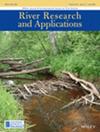Towards biogeomorphic river restoration: Vegetation as a critical driver of physical habitat
IF 1.7
4区 环境科学与生态学
Q4 ENVIRONMENTAL SCIENCES
引用次数: 0
Abstract
The current focus of river restoration on flow and sediment transfer without proper consideration of vegetation as a key structuring agent, beyond its stabilising effect, is too simplistic. We contend that vegetation has an essential role in shaping the physical fluvial environment and should be considered equally alongside hydrogeomorphic processes in restoration projects. In support, we introduce engineer plants as important controls, along with flowing water and transported sediments, on the morphodynamics of river systems and associated physical habitat development. The effect of vegetation on channel planform is then summarised, the influence of vegetation on hydrogeomorphic connectivity is outlined, and then the role of vegetation in landform development and habitat provision, as encapsulated in the fluvial biogeomorphic succession model, is described. We then present examples demonstrating how vegetation has contributed to the recovery of degraded rivers through biogeomorphic processes. Finally, we advance the concept of biogeomorphic river restoration by proposing principles to support a closer synthesis of the component sciences and list key areas for practitioners to focus on. Vegetation succession has a significance that goes beyond its physical structure or influence on sediment stability. In many river settings, it is central to channel evolution. The coupled assembly of plant communities and fluvial landforms affect the development of spatially and temporally dynamic habitat through biogeomorphic interactions. Restoration approaches that do not fully consider this dynamic may fail to anticipate river behaviour and recovery trajectories.努力恢复河流的生物地貌:植被是物理生境的关键驱动因素
目前,河流修复的重点是水流和沉积物的转移,而没有适当考虑到植被除了具有稳定作用外,还是一种关键的结构介质,这种做法过于简单化。我们认为,植被在塑造河道物理环境方面起着至关重要的作用,在修复项目中,应将其与水文地质过程同等对待。为了支持这一观点,我们介绍了工程植物,它们与流水和搬运的沉积物一起,对河流系统的形态动力学和相关的物理生境发展起着重要的控制作用。随后,我们总结了植被对河道平面形态的影响,概述了植被对水文地质连通性的影响,然后介绍了植被在地貌发展和栖息地提供方面的作用,这些都包含在河道生物地貌演替模型中。然后,我们举例说明植被如何通过生物地貌过程促进退化河流的恢复。最后,我们推进了生物地貌河流恢复的概念,提出了支持更紧密地综合各组成部分科学的原则,并列出了实践者需要关注的关键领域。植被演替的意义超出了其物理结构或对沉积物稳定性的影响。在许多河流环境中,植被演替是河道演变的核心。植物群落和河道地貌的耦合组合通过生物地貌的相互作用,影响着空间和时间上动态生境的发展。不充分考虑这种动态变化的恢复方法可能无法预测河流的行为和恢复轨迹。
本文章由计算机程序翻译,如有差异,请以英文原文为准。
求助全文
约1分钟内获得全文
求助全文
来源期刊

River Research and Applications
环境科学-环境科学
CiteScore
4.60
自引率
9.10%
发文量
158
审稿时长
6 months
期刊介绍:
River Research and Applications , previously published as Regulated Rivers: Research and Management (1987-2001), is an international journal dedicated to the promotion of basic and applied scientific research on rivers. The journal publishes original scientific and technical papers on biological, ecological, geomorphological, hydrological, engineering and geographical aspects related to rivers in both the developed and developing world. Papers showing how basic studies and new science can be of use in applied problems associated with river management, regulation and restoration are encouraged as is interdisciplinary research concerned directly or indirectly with river management problems.
 求助内容:
求助内容: 应助结果提醒方式:
应助结果提醒方式:


